🌿 Chapter 1: The Wheel Turns
Anamataggoyaṃ saṃsāro, pubbā koṭi na paññāyati.
“Samsāra has no beginning that can be seen.” Saṃyutta Nikāya
In Buddhist cosmology, reality is not linear. It spirals.
This spiral is called Samsāra, the Wheel of Becoming, where beings move through lifetimes across six realms: god, demigod, human, animal, hungry ghost, and hell-being. Each realm is both literal and symbolic: places of rebirth, but also states of mind we drift through daily.
The wheel spins because of karma, intentional actions and taṇhā, craving. Like gravity, karma pulls. Like fire, it burns. We chase, we cling, we become and so we are reborn.
But this cycle is not eternal law, it is conditioned. What is conditioned can be unconditioned. The Buddha did not teach how to make a better ride on the wheel, he taught how to step off it.
Theravāda emphasises anattā (no-self), viewing rebirth as a process without a permanent soul, while Mahāyāna’s Pure Land tradition trusts in Amitābha Buddha’s vow to guide devotees to a rebirth-free paradise. Vajrayāna, our focus in part III, illuminates the bardo’s visionary path.
For the Gnostic seeker, this teaching resonates: the world is not a blessing, but a trap of recurrence. Liberation is not ascension through the realms, but departure from the cycle itself.
⚡ TL;DR The Wheel Turns
- Samsāra is the endless cycle of birth, death, and rebirth
- It is powered by karma (intentional action) and taṇhā (craving)
- The six realms are psychological states as well as cosmic ones
- Awakening (nirvāṇa) means stepping off the wheel, not perfecting the ride
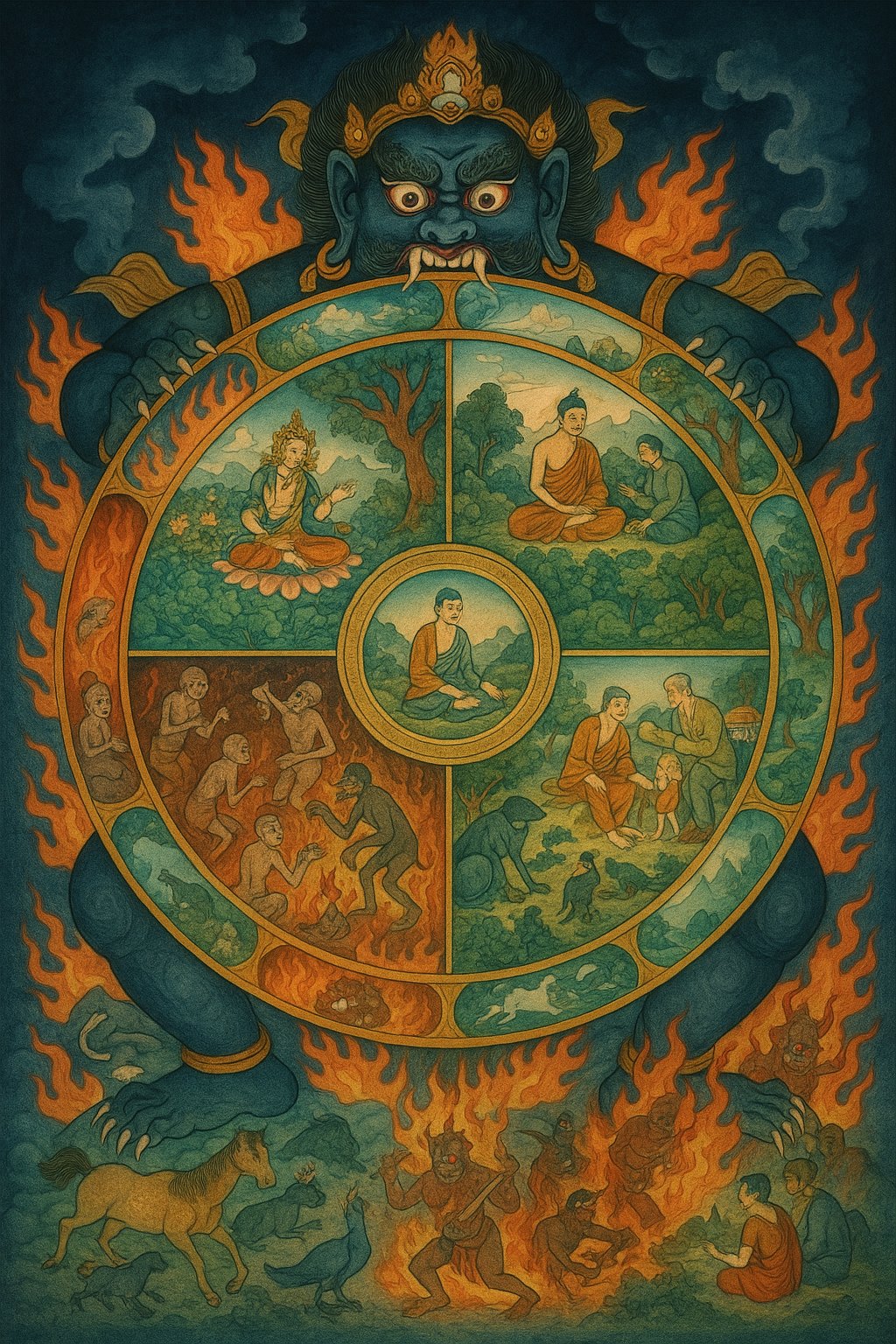
🔥 Chapter 2: The Karma Machine
Cetanāhaṁ, bhikkhave, kammaṁ vadāmi.
“It is intention, monks, that I call karma.” Anguttara Nikāya
Karma is not fate. It is not divine punishment, nor cosmic reward. In the Buddha’s words: karma is intention.
Every thought, word, and action plants a seed, shaping the conditions that follow. This is not metaphysics, it is the observable architecture of becoming.
Like a machine, karma generates momentum. The wheel turns not by accident, but because we fuel it: with craving, resistance, grasping, fear.
But karma is not static. Its engine can be stopped. In fact, that’s the aim of the Buddhist path, to end the cycle by ending the fuel. To act without clinging. To do without becoming.
For Gnostic seekers, this resembles the Archonic system, a spiritual mechanism built on false desire and illusion. Karma is the script of the false world. Liberation requires stepping beyond the script entirely.
⚡ TL;DR The Karma Machine
- Karma means intention, not fate, judgement, or cosmic reward
- Every act shapes future experience, like seeds growing into fruit
- The “machine” of becoming is driven by craving and aversion
- Freedom begins when we stop planting karmic seeds
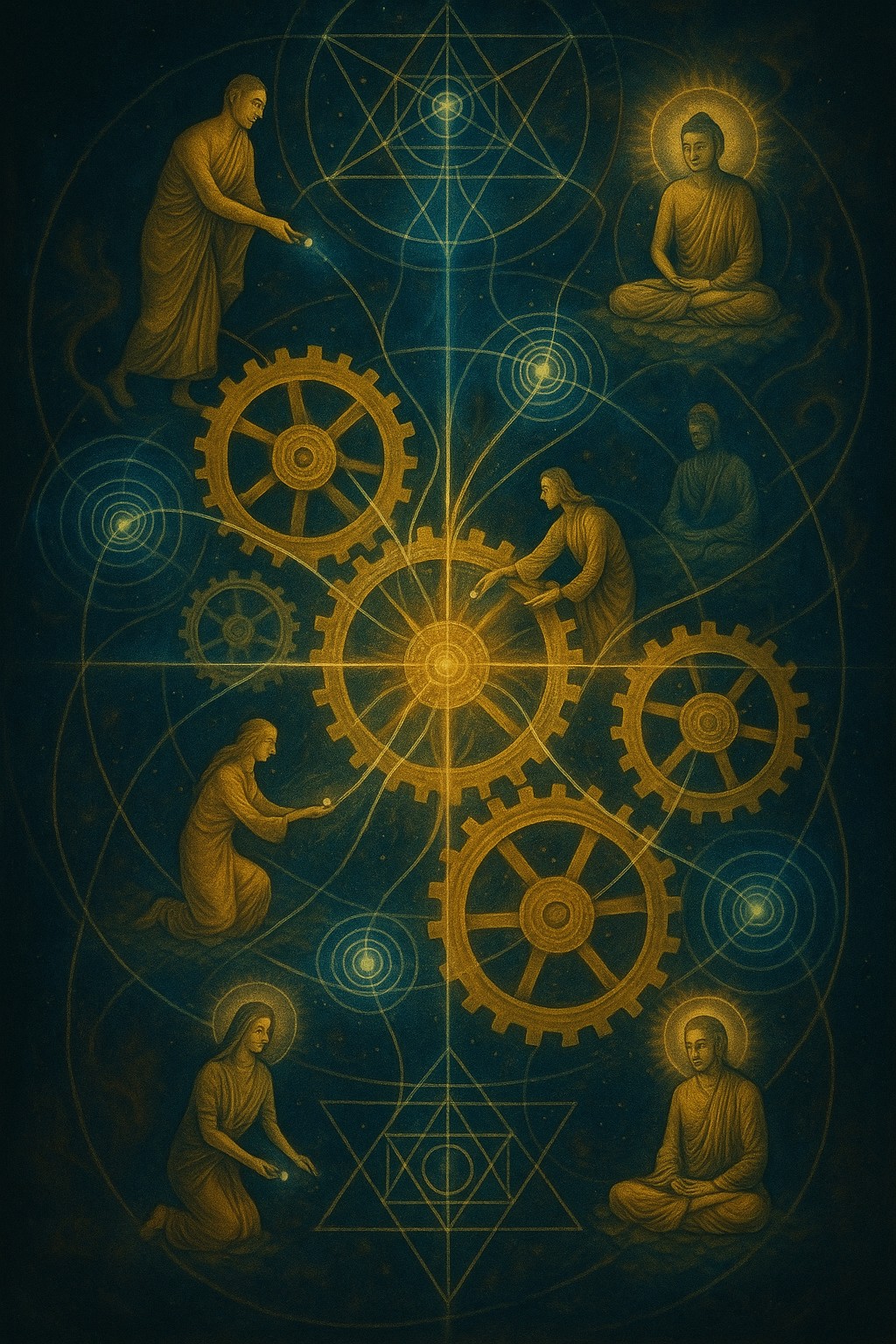
🌫️ Chapter 3: The Realm-Mirror
Saṃsāraṁ nāma loko, dukkhasamudayagāminī paṭipadā.
“This world of samsāra is a cycle; its path leads to the arising of suffering.” Dhammapada
In Buddhist cosmology, the six realms of existence are often described as literal rebirths, but they are also mirrors of mind. You do not need to die to visit them. You pass through them daily.
They are:
- Deva (God) Realm — pleasure, distraction, spiritual pride
- Asura (Demigod) Realm — jealousy, egoic striving, competition
- Human Realm — balance of joy and suffering, potential for awakening
- Animal Realm — instinct, fear, survival, ignorance
- Hungry Ghost Realm — addiction, craving, insatiable desire
- Hell Realm — rage, agony, torment, hatred
These are not punishments, they are reflections. Each realm reveals a dominant state of consciousness. Each one is a teaching. And every moment is a crossroads: which realm are you in?
The Buddha taught that the human realm is the rarest, because it balances clarity and suffering. It offers the best chance for awakening. Gnostics would call it the midpoint of the labyrinth, where the false light and true light are both visible.
To understand the realms is to understand the self. To pass through them consciously is to begin breaking the wheel.
⚡ TL;DR The Realm-Mirror
- The six realms are both cosmic and psychological, we visit them in life
- Each realm mirrors a dominant state: pride, jealousy, craving, fear, rage, or clarity
- The human realm holds the rare opportunity to awaken
- Every moment is a shift, awareness reveals your current realm

🔗 Chapter 4: The Breaking of the Chain
Imasmiṁ sati idaṁ hoti, imassuppādā idaṁ uppajjati.
“When this is, that is. From the arising of this, that arises.” The Buddha, on Dependent Origination
The Buddha taught that suffering is not random, it is structured. A patterned chain. A recursive loop.
This structure is called Paṭicca-Samuppāda, Dependent Origination. It describes the twelve interlinked links of becoming, each giving rise to the next:
- Ignorance (avijjā) — Not knowing the true nature of reality. The primal blindness to impermanence, non-self, and the nature of suffering. It is the root illusion that sets the cycle in motion.
- Volitional Formations (saṅkhāra) — Conditioned impulses or karmic actions, shaped by ignorance. These are the seeds, mental, verbal, physical, that shape future experiences.
- Consciousness (viññāṇa) — Awareness conditioned by past karma. This is not pure awareness, but a specific stream of perception tied to karmic tendencies.
- Name and Form (nāma-rūpa) — The arising of body and mind: sensation, perception, thought, identity. Consciousness crystallises into a new being.
- Six Sense Spheres (saḷāyatana) — The development of the five senses and the mind as a sixth. The apparatus of perception is re-established.
- Contact (phassa) — When the senses meet objects, contact arises, a spark between subject and object.
- Feeling (vedanā) — From contact arises feeling: pleasant, unpleasant, or neutral. This is the raw experience of sensation.
- Craving (taṇhā) — Feeling gives rise to desire, the thirst to possess, to avoid, or to repeat. The mind begins to reach.
- Clinging (upādāna) — Craving intensifies into attachment. The mind grabs onto ideas, identities, objects, relationships.
- Becoming (bhava) — Clinging sets into motion the process of becoming, the karmic momentum that conditions the next existence.
- Birth (jāti) — The arising of a new life, form, or identity, not only literal birth, but any moment we "become" something again.
- Decay and Death (jarāmaraṇa) — Every arising ends. With birth comes aging, dissolution, and death, followed by grief, lamentation, and the wheel beginning again.
This is the engine of Samsāra, a loop that creates identity, rebirth, and suffering. But it is not eternal. Each link is conditional. If you break one link, the chain stops.
Gnostic teachings echo this. The soul, caught in the Archons’ illusions, descends through layers of ignorance and craving. But at any gate, it can remember. It can turn back.
To see the links is to weaken them. To see the wheel is to begin stepping off.
⚡ TL;DR The Breaking of the Chain
- Dependent Origination maps the cycle of rebirth as 12 linked causes
- The cycle begins with ignorance and ends in death, then restarts
- Each link is conditional, awareness at any point breaks the chain
- Gnostics mirror this with the soul’s descent into illusion and ascent through memory

🌑 Chapter 5: The Great Forgetting
Avijjā paccayā saṅkhārā
“With ignorance as condition, formations arise.” Paṭicca-Samuppāda, Link 1
All things begin in forgetting.
In Buddhism, the first link of the cycle of rebirth is avijjā, ignorance. Not mere lack of knowledge, but the primordial blindness to the truth of impermanence, non-self, and suffering.
It is the ignorance that believes in a fixed “I,” that grasps for permanence in the impermanent, that mistakes craving for joy and the world for a home. It is this illusion that births karma, and the entire wheel turns from there.
The Gnostic vision mirrors this: we are born not in innocence, but in amnesia. The soul forgets its origin in the Pleroma. Memory fades. The divine spark is buried. The veil falls.
This is the Great Forgetting, and every birth is a repetition of it.
⚡ TL;DR The Great Forgetting
- Ignorance (avijjā) is the first cause in the cycle of rebirth
- It means forgetting the true nature of reality: impermanence, non-self, and suffering
- This ignorance births karma and sets the wheel of samsāra spinning
- In Gnostic thought, it mirrors the soul’s loss of divine memory and descent into illusion
- Awakening begins when remembering begins, to see clearly is to return

🪞 Chapter 6: The Mirror of the Realms
Yathāpi bhamaro pupphaṃ, vaṇṇagandhamaheṭhayaṃ,
paleti rasamādāya, evaṃ gāme munī care.
“Like a bee gathering nectar without harming the flower, live in the world without attachment.” Dhammapada 49
In Buddhist cosmology, existence spans six realms, each shaped by karma, each offering a distorted mirror of the mind. These realms are:
- Deva (God) Realm —a realm of bliss and beauty, but sedated by spiritual pride and complacency
- Asura (Demi-God) Realm — dominated by jealousy, rivalry, and restless striving
- Human Realm — balanced between pleasure and suffering, it offers the clearest chance for awakening
- Animal Realm — ruled by instinct, ignorance, and fear
- Preta (Hungry Ghost) Realm — defined by insatiable craving and emotional famine
- Naraka (Hell) Realm — tormented by rage, hatred, and anguish
These are not just post-mortem destinations, they are states of consciousness that rise and fall within a single day, or a single life. One moment in divine ease, the next in ghost-like hunger. This is the inner wheel.
To see the realms as mirrors is to begin waking. What we experience “out there” is often the echo of what moves within. For the Gnostic, this understanding deepens: each realm is not just psychological, but symbolic architecture, astral projections shaped by karma, ignorance, and archonic interference.
The great task is not to escape upward, but to pierce the illusion of all realms. Even heaven is samsāra. Even pleasure binds.
⚡ TL;DR The Mirror of the Realms
- The six realms are both places of rebirth and inner psychological states
- They reflect specific karmic tendencies: pride, jealousy, craving, fear, hatred, and ignorance
- Human life is considered the most precious realm for awakening
- All realms are impermanent, even god-realms decay
- Gnostic insight reveals them as illusions to transcend, not ideals to seek
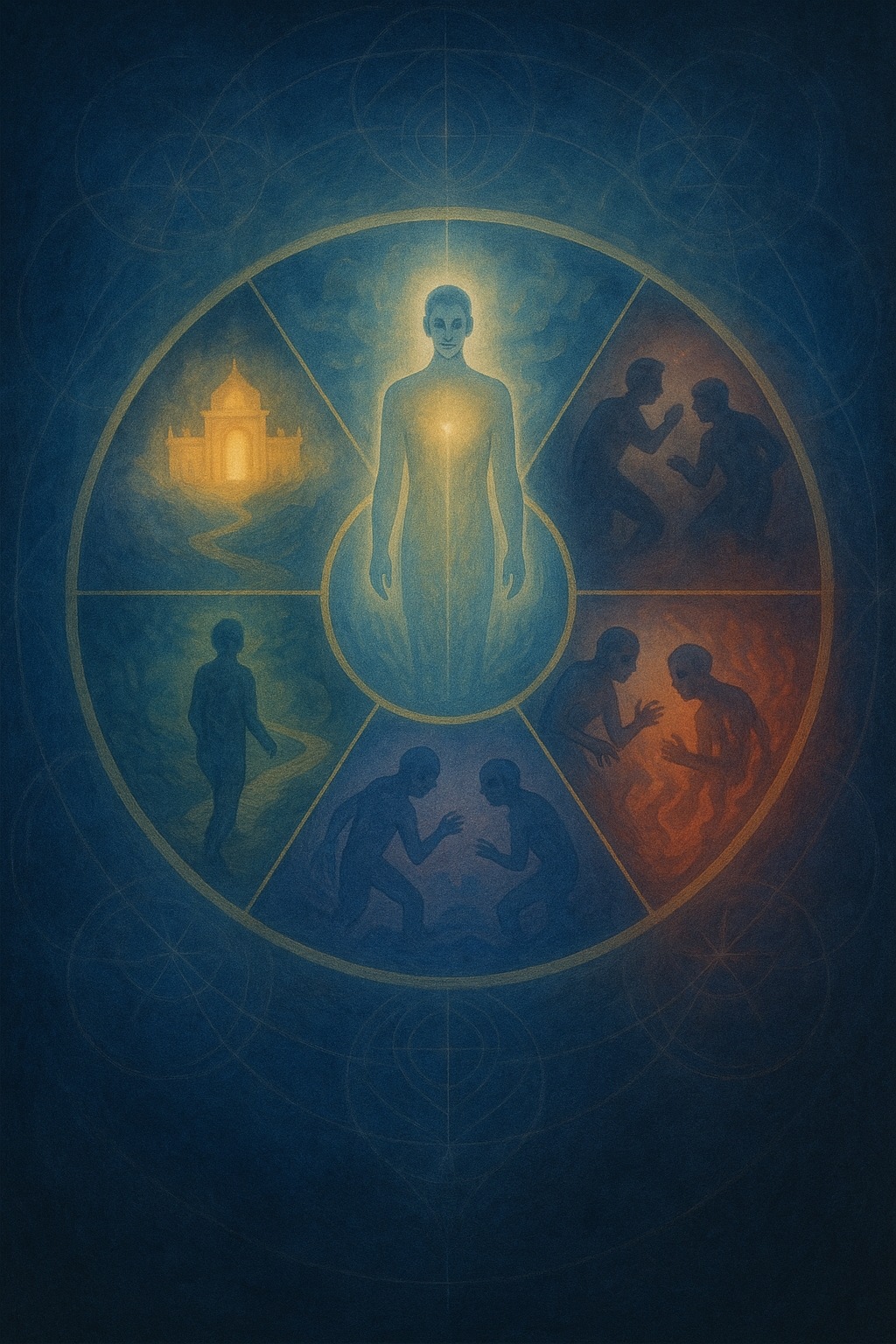
🗺️ Visual Map: The Cycle of Samsāra
Navigate the wheel of rebirth and its exit:
- God Realm (Deva): Blissful, yet proud. Can you release ego?
- Demigod Realm (Asura): Striving, jealous. Can you find peace?
- Human Realm: Balanced, awake. Can you cultivate wisdom?
- Animal Realm: Instinctive, fearful. Can you rise above?
- Hungry Ghost Realm: Craving, empty. Can you let go?
- Hell Realm: Tormented, hateful. Can you transform pain?
Beyond all six lies a hidden gate, Nirvāṇa: Unbound, radiant. Can you recognise the Clear Light?
This map mirrors your mind’s states, choose awareness to step off the wheel.
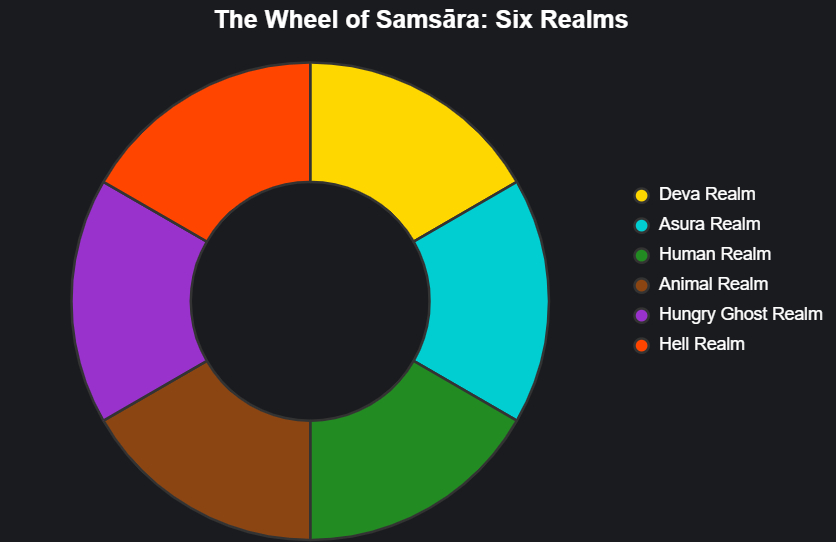
🔥 Chapter 7: The Middle Way is Fire
Na kāmānandaṃ anuyutto, na ca attakilamathānuyogi.
“Not addicted to indulgence, nor given to self-mortification.” The Buddha, on the Middle Way
After abandoning a life of princely luxury, the Buddha turned to extreme asceticism, fasting, silence, self-punishment. But he found no peace. His body collapsed. His mind frayed.
Then came the revelation: neither indulgence nor denial liberate the soul. Both are traps. The path lies in the middle, fierce in discipline, yet free from violence.
This is the Middle Way: a razor’s edge. It does not reject desire with hatred, nor embrace it with craving. It meets the fire without burning.
For the Gnostic, this teaching resonates as a method of gnosis-in-the-world: one must walk awake in a realm of illusion without falling for its temptations, nor fleeing into spiritual bypassing. The world must be met and seen through, not denied or decorated.
Balance is not softness, it is fire under control. Discipline with compassion. Awareness that does not flinch.
⚡ TL;DR The Middle Way
- The Middle Way avoids both sensual indulgence and extreme denial
- It is a path of balance, clarity, and disciplined awareness
- Desire is not evil, but must be understood, not obeyed
- Renunciation is not self-hatred, but self-liberation
- The Gnostic and Buddhist both walk the edge, seeing illusion, but not enslaved by it

💨 Chapter 8: The Gate of Death
Yathā pi pabbato selo, acalo suppatiṭṭhito;
Evaṃ mohakkhayā bhikkhu, pabbataṭṭhova santimā.
"Just as a mountain of rock, unshaken and firmly established,
so too a monk, with delusion destroyed, stands like a mountain, peaceful." Dhammapada 6:7
In Buddhist teaching, death is not the end. It is a moment of tremendous significance, a gateway where the illusions of solidity, self, and control dissolve.
At death, the body collapses, but the stream of consciousness does not vanish. It moves. It carries forward the imprints of karma, memories, tendencies, unfinished desires, into the space between lives.
This is the entry into the Bardo: the in-between state. A place of dreams, visions, revelations, and distortions, all shaped by the mind’s habits.
For the Gnostic, this threshold echoes the moment of the soul’s separation from the counterfeit body, a peeling away from the illusion of form to face the mirror of truth.
To die consciously is to pass through this gate with awareness. Not to escape fear, but to meet it without clinging.
⚡ TL;DR The Gate of Death
- Death is not the end but the beginning of a transitional state, the Bardo
- Consciousness continues after death, carrying karma and impressions
- The Bardo is shaped by the habits and fears of the mind
- Awareness at death allows one to pass through the gate without confusion
- Gnostic teaching echoes this: the soul must leave the illusion-body and remember its origin

🪞 Chapter 9: The Mirror of the Mind
སེམས་ཀྱིས་དཔག་ཏུ་མེད་པའི་རྒྱུ་མཚན་སྐྱེད་པར་བྱེད་དོ།
“By the mind, it gives rise to innumerable causal phenomena.” Bardo Thodol (Tibetan Book of the Dead)
In the Bardo, there is no body, only mind. But the mind is not empty. It creates.
Everything repressed, ignored, denied, or craved begins to arise in dream-like form. Frightening visions. Beautiful illusions. Longing. Guilt. Bliss. Regret.
This is not punishment, it is reflection. The Bardo becomes a mirror of the mind, a psychic theatre where karmic imprints play out in full color.
If the soul panics, it grasps at these visions and falls into a new rebirth. If the soul remains calm and aware, it recognises these appearances as mind-made, and may transcend them.
Gnostic parallels are profound. The Archons project illusions to trap the soul. But those illusions have no power once seen for what they are: shadows of the self. The awakened mind does not fight the dream, it sees through it.
⚡ TL;DR The Mirror of the Mind
- The Bardo reflects the mind, every fear, desire, and action appears as vision
- These appearances are mind-made, not external judgements
- Clinging leads to rebirth; awareness opens the gate to liberation
- Gnostic echoes: illusion falls when the soul sees through the veil
- The soul’s task: remain clear and detached in the midst of projection
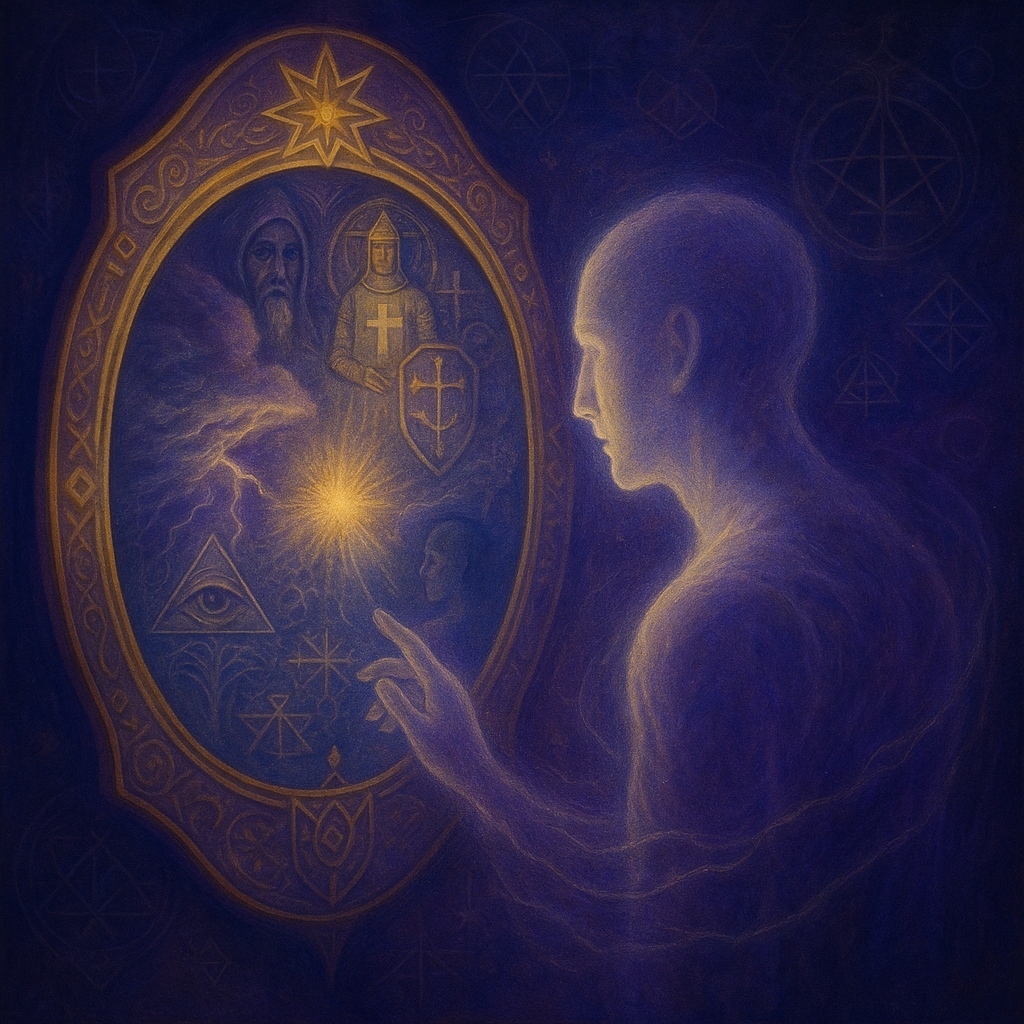
🌑 Chapter 10: The Lords of Light and Shadow
ཞལ་གྱི་འོད་དམར་ནི་གདུགས་སྣང་རྫུན་པའི་སྣང་བ་ཡིན།
“The red light of [zhal] is an intense/overwhelming illusory appearance.” Bardo Thodol (Tibetan Book of the Dead)
On the second week in the Bardo, figures of dazzling light and terrible form begin to appear.
Some radiate compassion and peace, these are the peaceful deities. Others roar in flame and shadow, these are the wrathful deities. Both are aspects of the same truth.
They are not gods in the Western sense. They are projections of the soul’s mind, infused with karmic charge. If one meets them with terror or desire, the soul recoils, and spirals into rebirth. But if one sees through the projection, the deity becomes a portal of release.
To the Gnostic, these figures echo the Archons and Aeons, symbolic powers that appear to the soul at threshold moments. The Archons seek to bind; the Aeons to awaken. But both are masks. Only the unconditioned spark beneath them is real.
All forms in the Bardo, light or shadow, are dreams. Recognition, not worship or resistance, is the way through.
⚡ TL;DR The Lords of Light and Shadow
- Peaceful and wrathful deities arise in the Bardo as aspects of the soul’s karma
- They are not separate beings, but projections of mind infused with symbolic meaning
- Terror or craving binds the soul; recognition leads to freedom
- Gnostic resonance: these figures parallel Archons (binders) and Aeons (liberators)
- All forms are illusory, to see clearly is to step through the veil
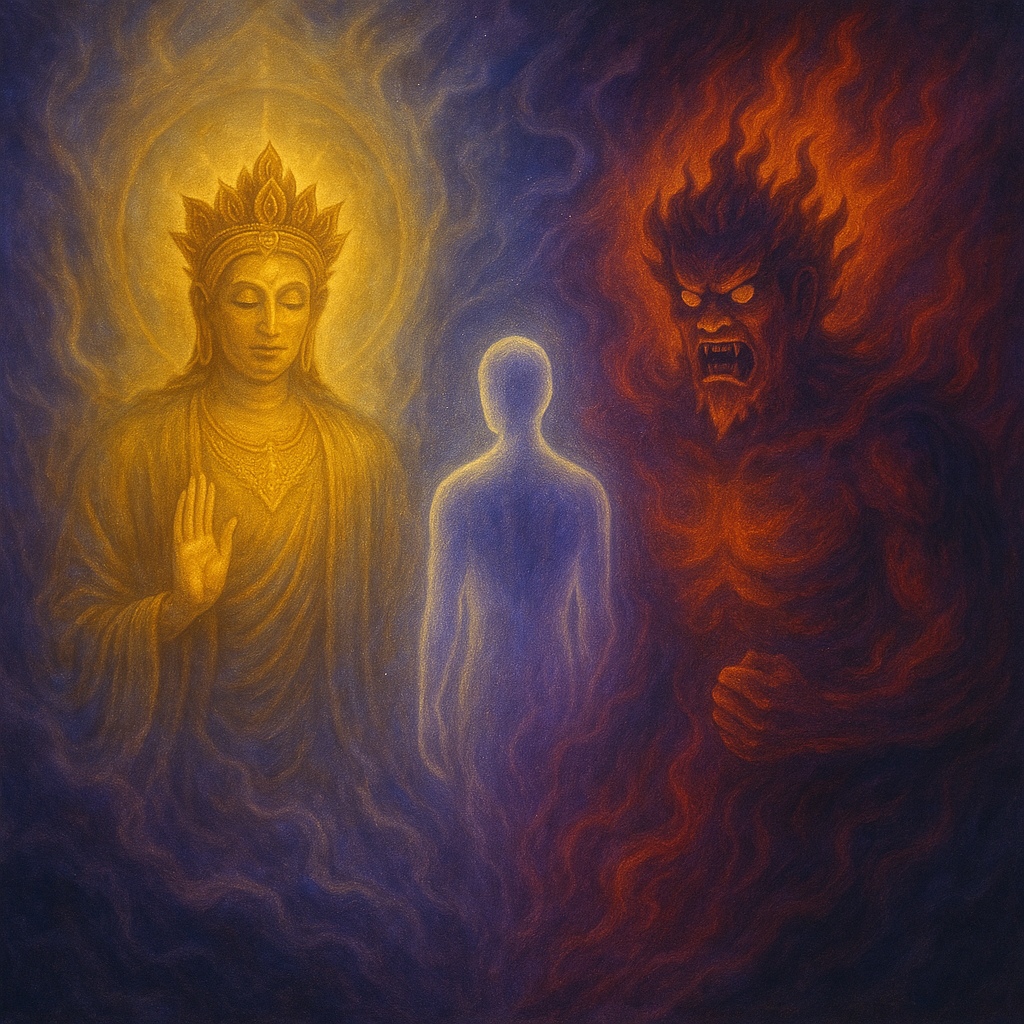
🌘 Chapter 11: The judgement Is You
“Attanā va kataṃ pāpaṃ, attanā saṃkilissati.”
“By oneself is evil done; by oneself is one defiled.” Dhammapada, Verse 165
There is no judge in the Bardo. No heavenly court. No cosmic scale. Only reflection.
Consciousness sees the echoes of every deed, word, and thought, not as punishment, but as vibration.
Everything unresolved rises. Everything clung to clings back.
This moment has been called “the weighing of the heart.” But it is not your heart being weighed. It is you, weighing your own soul.
For the Gnostic, this is the encounter with the mirror of Sophia, where false selves burn away, and only what is real remains. The Archons may have asked questions. But now, you are both question and answer.
If the Consciousness cannot look upon its own karma without fear, it recoils. And the wheel turns again.
⚡ TL;DR The judgement Is You
- There is no external judge in the Bardo, only the soul facing its own reflection
- Unresolved karma appears not as punishment, but as echo and form
- The soul’s ability to meet itself without fear determines the outcome
- Gnostic parallel: Sophia’s mirror, the revelation of truth beneath illusion
- This is the pivot: acceptance liberates; resistance reincarnates

🌕 Chapter 12: The Clear Light
འོད་གསལ་དང་རང་རིག་གཉིས་མེད་ཡིན།
“The Clear Light and innate awareness are not two.” Tibetan Book of the Dead
In the deepest silence of the Bardo, all forms fall away.
No more deities. No more mirrors. No more fear. Only radiance, unbounded, silent, infinite.
This is the Clear Light. It is not a tunnel. Not a god. It is your original awareness, before thought and form.
To recognise it is liberation. To recoil from it is rebirth.
Most beings turn away. The Light is too vast, too formless, too pure. The ego clings to story. To shape. To sensation. And so, the wheel turns again.
But the awakened one does not fear the Light. They become it.
For the Gnostic, this is the moment the divine spark remembers itself,not as a self, but as the Light behind all selves.
⚡ TL;DR The Clear Light
- The Clear Light is the soul’s original, unconditioned awareness
- It appears after death as pure radiance, formless, infinite, silent
- To recognise it without fear is liberation (nirvāṇa)
- Most recoil, clinging to form, and are reborn
- Gnostically, it is the divine spark awakening beyond illusion

🗣️ Did You Glimpse the Light?
If you were to meet your own mind without form, fear, or story, would you recognise it?
After journeying through the Bardo, the Clear Light, and the illusions of self — what remains when the self dissolves?
- Have you ever known a moment where the mind was utterly still?
- Do you fear ego dissolution — or do you long for it?
- What does 'awakening' mean to you now, after this page?
Write your reflection in your journal or share it with the temple of seekers using #TheGnosticKey and tag @thegnostickey.
🧠 Quiz
Can you see through the veil of I?
📖 Glossary
Decode the language of awakening and illusion.
- Aeons
- Emanations of divine consciousness; forces of liberation and awakening.
- Anattā
- Non-self; the insight that there is no fixed, eternal 'I'.
- Anicca
- Impermanence; the ever-changing nature of all phenomena.
- Archons
- Rulers or gatekeepers of the lower worlds who bind the soul to illusion.
- Bardo
- The intermediate state between death and rebirth in Tibetan Buddhism.
- Chikhai, Chönyi, Sidpa Bardo
- The three main stages of the Bardo: moment of death, visionary state, and transition into rebirth.
- Clear Light
- The radiant awareness that appears after death; recognition of it brings liberation.
- Divine Spark
- The innermost fragment of true divinity within the soul, trapped in matter.
- Dukkha
- Suffering or dissatisfaction; the inescapable tension of conditioned life.
- Karma
- Intentional action, shaping both present and future conditions.
- Nirvāṇa
- Liberation; the unconditioned peace beyond craving and becoming.
- Ösel
- Tibetan term for the Clear Light of primordial awareness.
- Peaceful & Wrathful Deities
- Projections of the mind encountered in the Bardo; they represent wisdom and karmic energy.
- Samsāra
- The endless cycle of birth, death, and rebirth across six realms.
- Sophia
- The Gnostic embodiment of wisdom who falls and seeks redemption through the awakening of humanity.
- Taṇhā
- Craving or thirst; the force that perpetuates rebirth.
- Twelve Nidānas
- The twelve-linked chain of dependent origination explaining the process of samsāric rebirth.